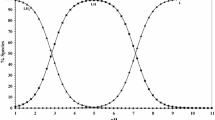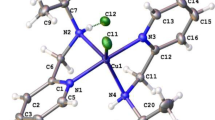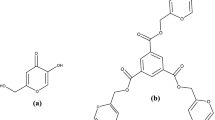Abstract
A selection of nine macrocyclic FeIII/II and CoIII/II transition metal complexes has been chosen to serve as a universal set of mediator-titrants in redox potentiometry of protein samples. The potential range spanned by these mediators is approximately from +300 to −700 mV vs the normal hydrogen electrode, which covers the range of most protein redox potentials accessible in aqueous solution. The complexes employed exhibit stability in both their oxidized and their reduced forms as well as pH-independent redox potentials within the range 6 < pH < 9. The mediators were also chosen on the basis of their very weak visible absorption maxima in both oxidation states, which will enable (for the first time) optical redox potentiometric titrations of proteins with relatively low extinction coefficients. This has previously been impractical with organic mediators, such as indoles, viologens and quinones, whose optical spectra interfere strongly with those of the protein.




Similar content being viewed by others
Abbreviations
- EPR:
-
Electron paramagnetic resonance
- NHE:
-
Normal hydrogen electrode
References
Clark WM (1960) The oxidation–reduction potentials of organic systems. Williams and Wilkins, Baltimore
Dutton PL (1978) Methods Enzymol 54:411–435
Wilson GS (1978) Methods Enzymol 54:396–410
Meckstroth ML, Norris BJ, Heineman WR (1981) Bioelectrochem Bioenerg 8:63–70
Fultz ML, Durst RA (1982) Anal Chim Acta 140:1–18
Bernhardt PV, Lawrance GA, Hambley TW (1989) J Chem Soc Dalton Trans 1059–1065
Bernhardt PV, Comba P, Hambley TW (1993) Inorg Chem 32:2804–2809
Geue RJ, Hambley TW, Harrowfield JM, Sargeson AM, Snow MR (1984) J Am Chem Soc 106:5478–5488
Creaser II, Harrowfield JM, Herlt AJ, Sargeson AM, Springborg J, Geue RJ, Snow MR (1977) J Am Chem Soc 99:3181–3182
Bruce JI, Gahan LR, Hambley TW, Stranger R (1993) Inorg Chem 32:5997–6002
Donlevy TM, Gahan LR, Hambley TW, Stranger R (1992) Inorg Chem 31:4376–4382
Bernhardt PV, Bygott AMT, Geue RJ, Hendry AJ, Korybut-Daszkiewicz BR, Lay PA, Pladziewicz JR, Sargeson AM, Willis AC (1994) Inorg Chem 33:4553–4561
Wieghardt K, Schmidt W, Herrmann W, Kueppers HJ (1983) Inorg Chem 22:2953–2956
Wieghardt K, Bossek U, Chaudhuri P, Herrmann W, Menke BC, Weiss J (1982) Inorg Chem 21:4308–4314
Stanbury DM (1989) Adv Inorg Chem 33:69–138
Myer YP, Saturno AF, Verma BC, Pande A (1979) J Biol Chem 254:11202–11207
Norris BJ, Meckstroth ML, Heineman WR (1976) Anal Chem 48:630–632
Eddowes MJ, Hill HAO (1977) J Chem Soc Chem Commun 771–772
Taylor JF, Morgan VE (1942) J Biol Chem 144:15–20
Mie Y, Sonoda K, Kishita M, Krestyn E, Neya S, Funasaki N, Taniguchi I (2000) Electrochim Acta 45:2903–2909
Liu A, Wei M, Honma I, Zhou H (2005) Anal Chem 77:8068–8074
Johnson JM, Halsall HB, Heineman WR (1983) Anal Biochem 133:186–189
Zhang C, Haruyama T, Kobatake E, Aizawa M (2000) Anal Chim Acta 408:225–232
Bourbonnais R, Rochefort D, Paice MG, Leech D (2001) ACS Symp Ser 785:391–399
Winkler JR, Gray HB (1992) Chem Rev 92:369–379
Bechtold R, Kuehn C, Lepre C, Isied SS (1986) Nature 322:286–288
Che CM, Margalit R, Chiang HJ, Gray HB (1987) Inorg Chim Acta 135:33–35
Conrad DW, Scott RA (1989) J Am Chem Soc 111:3461–3463
Luo J, Wishart JF, Isied SS (1998) J Am Chem Soc 120:12970–12971
Mauk AG, Bordignon E, Gray HB (1982) J Am Chem Soc 104:7654–7657
Macyk J, van Eldik R (2003) Dalton Trans 2704–2709
Carney MJ, Lesniak JS, Likar MD, Pladziewicz JR (1984) J Am Chem Soc 106:2565–2569
Ficke JT, Pladziewicz JR, Sheu EC, Lappin AG (1991) Inorg Chem 30:4282–4285
Pladziewicz JR, Accola MA, Osvath P, Sargeson AM (1993) Inorg Chem 32:2525–2533
Mizuta T, Yamamoto T, Miyoshi K, Kushi Y (1990) Inorg Chim Acta 175:121–126
Mizuta T, Wang J, Miyoshi K (1993) Bull Chem Soc Jpn 66:2547–2551
Ozarowski A, McGarvey BR, Drake JE (1995) Inorg Chem 34:5558–5566
Sharma VK, Szilagyi PA, Homonnay Z, Kuzmann E, Vertes A (2005) Eur J Inorg Chem:4393–4400
Pohl K, Wieghardt K, Kaim W, Steenken S (1988) Inorg Chem 27:440–447
Pilbrow JR (1990) Transition ion electron paramagnetic resonance. Oxford University Press, Oxford
Acknowledgements
We gratefully acknowledge financial support from the Australian Research Council (DP0343405). We also thank L.R. Gahan for a generous gift of [Co(AMME-N5S-sar)]Cl3 and [Co(CLME-N4S2-sar)]Cl3.
Author information
Authors and Affiliations
Corresponding author
Electronic supplementary material
Rights and permissions
About this article
Cite this article
Bernhardt, P.V., Chen, KI. & Sharpe, P.C. Transition metal complexes as mediator-titrants in protein redox potentiometry. J Biol Inorg Chem 11, 930–936 (2006). https://doi.org/10.1007/s00775-006-0148-z
Received:
Accepted:
Published:
Issue Date:
DOI: https://doi.org/10.1007/s00775-006-0148-z




